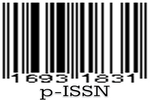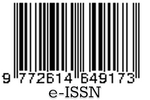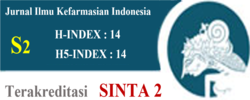Optimization of oil-based liquid lipstick formula from sesame seed oil (Sesamum indicum L.) and antibacterial activity test against Staphylococcus aureus
Abstract
Liquid lipstick is a type of lip color cosmetic that consumers highly favor. However, repeated use of liquid lipstick can promote the growth of Staphylococcus aureus (S. aureus) bacteria. The formulation of liquid lipstick involves several components, including a mixture of wax, oil, and other additives. Sesame seed oil (Sesamum indicum L.), incorporated into the formulation, serves as both a base and preservative due to its fatty acid content, which is expected to inhibit the growth of S. aureus bacteria. Microcrystalline wax is added to achieve a good texture and enhance the adhesion properties of the formulation. This study aimed to determine the optimum formula and evaluate the antibacterial activity of the liquid lipstick formulation. The formula was developed using a 2² factorial design method, with sesame seed oil and microcrystalline wax as variables. The optimum formula was analyzed using Design Expert® 13 software based on parameters such as viscosity, spreadability, and adhesion. The final optimum formula consisted of 70% sesame seed oil and 5% microcrystalline wax. The formulation demonstrated good stability during the cycling test, maintaining red color, vanilla and sesame-like aroma, liquid texture, and pH 5. The viscosity was 11797.51 cP, the spreadability was 6.06 cm, and the adhesion time was 64 seconds. Antibacterial activity, assessed using the disk diffusion method, yielded an inhibition zone diameter of 15±1.322 mm, indicating a strong inhibition zone. Based on the research findings, it was concluded that the optimum sesame seed oil-based liquid lipstick formula exhibited good product characteristics, stability, and strong antibacterial activity.
References
[2] M. S. Balsam, E. Sagarin, Ed, “Cosmetics: Science and technology. John Willey & Sons, 1972.
[3] A. O. Barel, M. Paye, H. I. Maibach, Ed, “ Handbook of cosmetics science and technology, 3rd Edition. Informa Healthcare USA, Inc, New York, 2009.
[4] K. R. Anilakumar, A. Pal, F. Khanum, A. S. Bawa, “ Nutritional, medicinal and industrial uses of sesame (sesamum indicum l.) seeds- an overview,” Agriculture Conspectus Scientificus, vol. 75, no. 4, pp. 159-168, 2010.
[5] A. Saeed, A. A. Aseelabid, M. M. Yahya, A. Saad, M.S. Sivagurunathan, A. H. Ahmed, R. Ziaur, A. M. Firoz, “ Chemical characterization and antibacterial efficacy of saudi sesame oil against human pathogenic bacteria,” Enviroment Conservation Journal, 21 (1&2), pp. 19-29, 2020.
[6] R. H. Soureshjani, Z. Obeidavi, V.R. Vanani, S. E. Dehkordi, N. Fattahyan, A. Gholipour, “ Evaluation of antibacterial effect of sesame oil, olive oil and their synergism on staphylococcus aureus in vitro,” Advanced Herbal Medicine, vol. 3, no. 3, pp. 13-19, 2016.
[7] D. M. Wenas, J. Suardi, W. Wahidin, ” Uji cemaran mikroba pada sediaan lipstik cair, “ Journal of Science and Technology, vol. 1, no. 1, pp. 49-60, 2020.
[8] R. Campana, C. Scesa, V. Patrone, E. Vittoria, W. Baffone, “ Microbiological study of cosmetic product during their use by consumers: health risk and efficacy of preservative systems,” Journal Compilation The Society for Applied Microbiology, vol. 43, no. 3, pp. 301-306, 2006.
[9] Jessica, L. Rijai, H. Arifian, Eds., Optimalisasi Basis Untuk Formulasi Sediaan Lip Cream, Proceeding of the 8th Mulawarman Pharmaceuticals Conferences, vol. 8(1), pp. 260-266, 2018.
[10] Departemen Kesehatan Republik Indonesia, Farmakope Indonesia ed III, Departemen Kesehatan Republik Indonesia, Jakarta, Indonesia, 1979.
[11] J. S. Jellinek, Formulation and Function of Cosmetics. John Wiley and sons Inc., New York. p. 428, 429, 1970.
[12] Nurhabibah, F. F. Sriarumtias, S. Rizqi, “Formulation of liquid lipstik from turmeric (curcuma longa L.) and cinnamon (cinnamomum burmanni) extract,” Jurnal Ilmiah Farmako Bahari, vol. 8, no. 1, pp. 41-52, 2017.
[13] S. Raissi, R. E. Farsani, “ Statistical process optimization thourgh multi response surface methodology,” World Academy of Science, Engineerring and Technology, vol. 3, no. 3, pp. 267-271, 2009.
[14] Badan Standardisasi Nasional, SNI 04-7182-2006, Standarisasi Nasional Indonesia, Jakarta, Indonesia, 2006.
[15] M. Balouiri, M. Sadiki, S. K. Ibnsouda, “ Methods for in vitro evaluating antimicrobial activity: A review,” Journal of Pharmaceutical Analysis, vol. 6, no. 2, pp. 71-79, 2016.
[16] Tranggono, R.I., Latifah, F, Buku pegangan ilmu pengetahuan kosmetik. Gramedia Pustaka Utama, Jakarta, Indonesia, 2007.
[17] H. C. Ansel, Pengantar Bentuk Sediaan Farmasi. Cetakan I. Diedit oleh Ibrahim. UI Press. Jakarta, 1989.
[18] A. M. Othman, M. A. Elsayed, A. M. Elshafei, M. M. Hassan, “Application of response surface methodology to optimize the extracellular fungal mediated nanosilver green synthesis,” Journal of Genetic Engineering and Biotechnology, vol. 15, no. 2, pp. 497-504, 2017.
[19] G. Pratiwi, R. Martien, R. Murwanti, “Chitosan nanoparticle as s delivery system for polyphenols from meniran extract (phyllanthus niruri L.) : Formulation, optimazation, and immunomodulatory activity,” International Journal of Applied Pharmaceutics, vol. 11, no. 2, pp. 50-58, 2019.
[20] W. W. Davis, T. R. Stout, “Disc plate method of microbiological antibiotic assay, I: factors influencing varibiality and error,” Applied Microbiology, vol. 22, no. 4, pp. 659-665, 1971.
[21] F. Dilika, P. D. Bremner, J. J. M. Meyer, ” Antibacterial activity of linoleic and oleic acids isolated from helichrysum pedunculatum : A plant used during circumcision rites, “ Fitoterapia, vol. 71, no. 4, pp. 450-452, 2000.
[22] L. J. McGaw, A. K. Jager, J. V. Staden, “Antibacterial effects of fatty acids and related compounds from plants South African Journal of Botany,” South African Journal of Botany, vol. 68, no. 4, pp. 417-423, 2002.
[23] BPOM, Peraturan Kepala Badan Pengawas Obat dan Makanan Republik Indonesia Nomor : HK.03.1.23.07.11.6662 tentang persyaratan cemaran mikroba dan logam berat dalam kosmetika, BPOM, Jakarta, 2011.
[24] Y. Damayanti, A. D. Lesmono, T. Prihandono, “Kajian pengaruh suhu terhadap viskositas minyak goreng sebagai rancangan bahan ajar petunjuk praktikum fisika,”Jurnal Pembelajaran Fisika, 7(3): 307-314. 2018.

This work is licensed under a Creative Commons Attribution-NonCommercial-ShareAlike 4.0 International License.
Licencing
All articles in Jurnal Ilmu Kefarmasian Indonesia are an open-access article, distributed under the terms of the Creative Commons Attribution-NonCommercial-ShareAlike 4.0 International License which permits unrestricted non-commercial used, distribution and reproduction in any medium.
This licence applies to Author(s) and Public Reader means that the users mays :
- SHARE:
copy and redistribute the article in any medium or format - ADAPT:
remix, transform, and build upon the article (eg.: to produce a new research work and, possibly, a new publication) - ALIKE:
If you remix, transform, or build upon the article, you must distribute your contributions under the same license as the original. - NO ADDITIONAL RESTRICTIONS:
You may not apply legal terms or technological measures that legally restrict others from doing anything the license permits.
It does however mean that when you use it you must:
- ATTRIBUTION: You must give appropriate credit to both the Author(s) and the journal, provide a link to the license, and indicate if changes were made. You may do so in any reasonable manner, but not in any way that suggests the licensor endorses you or your use.
You may not:
- NONCOMMERCIAL: You may not use the article for commercial purposes.
This work is licensed under a Creative Commons Attribution-NonCommercial-ShareAlike 4.0 International License.




 Tools
Tools





















